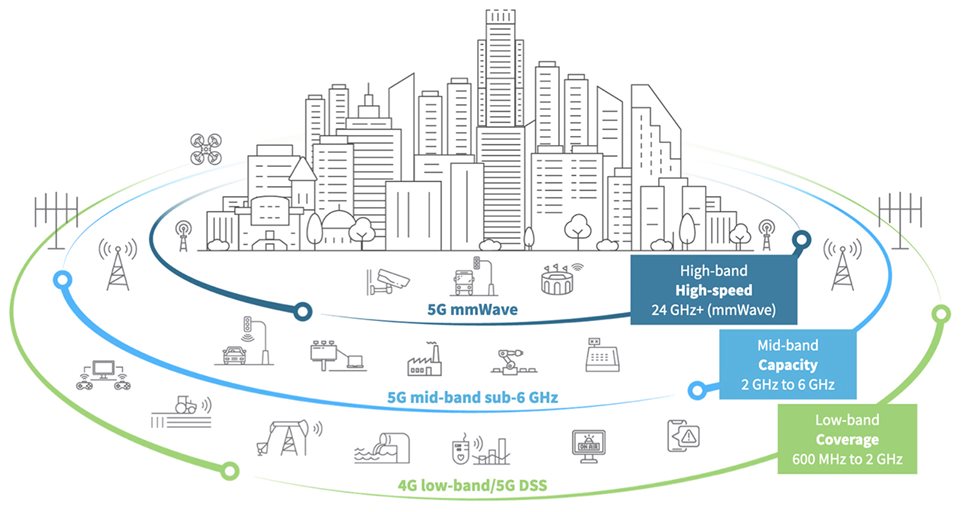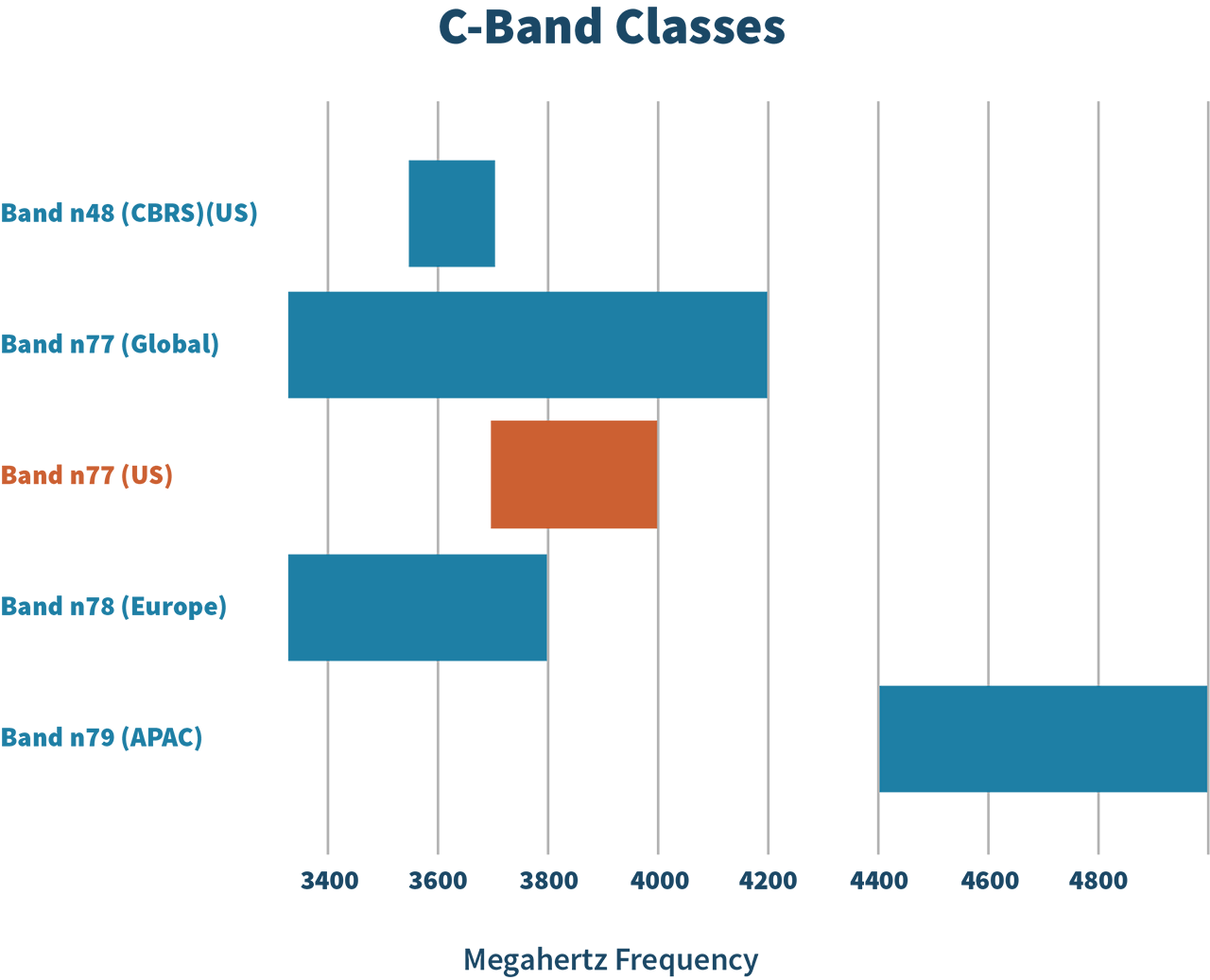5G is on its way to becoming a ubiquitous network across the globe, and over the past few years there has been a lot of excitement about 5G networks and what they could mean for businesses and consumers. If you are following the mobile network operator (MNO) battle over who has the best network, you may have heard carriers promoting “C-band” as the latest network differentiator.
What is C-band, and why is it important for 5G networks? In this blog post, we will help you understand what it is, how it works, why you need it and how to get it.
Take me to Digi 5G solutions
5G Spectrum Primer

5G networks rely on three specific frequency bands known as high-band, mid band and low-band. Each frequency band has benefits and challenges. Each mobile carrier incorporates 5G differently.
- High-band or millimeter wave (mmWave) 5G: High speed but short range. High band 5G frequencies range from 24 GHz to 100 GHz, making it incredibly fast — enabling multi-gigabit per second speeds. But these high frequencies have trouble going through buildings and walls, making it useful only for short distances.
- Mid-band 5G: Medium range, good speed. The mid band operates between 2-6 GHz and provides a longer range than the high-band, with good speeds in the gigabit per second range. In fact, this 5G spectrum is the most used 5G band and is commonly used on business campuses.
- Low-band 5G: Long range, slower speed. The low band operates below 2 GHz, but it is very crowded with 4G LTE traffic, It is commercially important for industry. IoT sensors can use low band 5G to monitor wind and solar farm conditions over large areas.
C-band is part of the mid-band spectrum and is really the perfect spectrum to enable new 5G use cases.
What Frequency Is C-band?
As the next generation network, 5G must offer an experience that’s noticeably better from 4G. To do that, it needs new spectrum. At frequencies between 3.7 and 4.2 GHz, C-band in the U.S. sits between the 2.4 GHz and 5 GHz Wi-Fi bands and is next to the Citizens Broadband Radio Service (CBRS) band (3.55 to 3.7 GHz). The latter is gaining popularity in the U.S. for 4G and 5G private cellular networks because its transmission characteristics are very well known, and its safety is well established.
Enter C-Band, the frequency that is key to 5G.


Is C-Band a New Band?
In the U.S., the FCC made 280 MHz of the mid-band spectrum available for 5G, auctioned as the C-band in late 2020. Verizon Wireless and AT&T won the largest percentage of licenses, gaining 90 percent of the 5,684 licenses awarded. Winning bids topped a record $81 billion from 21 different bidders. These mobile carriers will add the C-band spectrum to their 5G offerings to provide faster 5G for more locations.
So, what does that mean for the future of 5G? FCC Acting Chairwoman Jessica Rosenworcel shared her thoughts on the importance of this auction.
“This auction reflects a shift in our nation’s approach to 5G toward mid-band spectrum that can support fast, reliable, and ubiquitous service that is competitive with our global peers.”
But C-band is not a new band. Satellite TV employed C-band frequencies since the 1970s. As satellite TV companies began “packing” their broadcasts into the upper part of the C-band for better video quality, they freed up the lower part for cellular use. In fact, on October 4, 2022 two C-band satellites launched into space as part of a broader Federal Communications Commission (FCC) program to clear a part of the C-band spectrum.
In other words, it was part of a mandate for satellite operators to transition away from using the lower 300 MHz so that it is available for 5G.
Download our White Paper on 5G Frequency Bands
Learn about differences between 5G frequency bands, their benefits, and applications.
Download PDF
Why Do I Need C-Band?
For 5G to offer an experience that’s noticeably better than 4G, it needs new spectrum. And it needs wider channels — up to 100 MHz per channel — to provide more capacity and speed. In comparison, 4G networks today have up to only 20 MHz per channel. So 5G can carry 5 times the information over a single C-band channel.
- Faster speeds and more capacity than 4G with up to 100 Mbps on mobile devices
- Connectivity over longer distances between cell towers
- Large amounts of spectrum for mobile carriers
How Fast Is C-Band?
In today’s 5G Non-Standalone (NSA) cellular networks, most of the data traffic still flows over 4G LTE, with 5G providing a little extra bandwidth. This provides enhanced speeds without carriers having to rework much core network technology. More explicitly, a cellular device may combine three 5, 10 or 20 MHz-wide 4G channels plus a single 5G channel for another 5-20 MHz of bandwidth. This stitched together spectrum provides a total bandwidth of between 20-80 MHz and speeds between 100-200 Mbps.
In our own testing, we saw a significant improvement in locations that deployed C-band. With C-band’s wider channel, we observed 60 to 100 MHz wide channels with 5G network speeds of 600-700 Mbps or 4 to 5 times what 4G LTE provides. By 2023, next generation 5G devices will start to combine many C-band channels for even faster speeds in the gigabit to multi-gigabit range.
What Are the 5G C-Band Use Cases?
In September of 2021, Verizon Wireless struck a 10-year deal with the National Football League (NFL) to be its official 5G partner. As part of this deal, Verizon will use all of its spectrum, including the C-band, to deliver new 5G use cases for fans, public safety and concessions.
In Japan, GE Research announced the addition of C-Band 5G to its Niskayuna campus. The C-Band 5G network supports GE’s advanced research centers in aviation, energy and healthcare. It also enables high-speed wireless access for first responders and the Niskayuna community.
In the coming years, there will be many new use cases for C-band 5G. As deployment spreads, C-band 5G will provide a boost to augmented reality, virtual reality, video, manufacturing, health care, smart home installations and even drones. Imagine using your cellular connection to interact with your home appliances, your personal fitness trackers, your streaming content on your smart phones, tablets, computers and TVs — all at the same time, without delay or signal disruptions. This is the power of C-band 5G.
Here are a few other areas where C-band 5G is already having an impact.
- Fixed wireless access for home, enterprise and industry — C-band performs well indoors and opens new opportunities for enterprise applications. For example, large factories can enjoy real-time insights through IoT-connected sensors.
- Primary connectivity vs. failover - 5G can be used to backup existing fiber and Ethernet connectivity in schools, which experienced connectivity challenges during the pandemic.
- Data-intensive applications, such as video — An Australian-based construction company used C-band 5G to launch a holographic building visualization and real-time design displays.
- Data offloading over cellular — In areas where mobile network traffic is high, C-band 5G can help alleviate LTE network capacity issues.
Is C-band Available in Other Parts of the World?
In the US, C-band translates into 5G band n77, which mobile network operators like Verizon and AT&T have started to deploy.
Most European and Asian countries already use band n78, which is a subset of band n77 from 3.3 to 3.8GHz. According to Fierce Wireless, the first 23 countries to auction C-band spectrum include Australia, Austria, Czechia, Finland, Germany, Hong Kong, Hungary, Ireland, Italy, Latvia, Norway, Romania, Slovakia, South Korea, Spain and the U.K.
In fact, most of the rest of the world has already started to auction off C-Band. It is probably the most popular 5G band in the world.
What Digi Devices Support C-Band?
What could your business do if your network had 5 times more capacity and speed? As more parts of businesses become digitized, network speed and capacity matter. A lot. That’s why Digi designs its products with C-band in mind, putting you at the forefront of what’s possible.
Our Digi EX50 5G, Digi TX64 5G, Digi TX64 Rail 5G products all support C-band today. In fact, products shipping as of October 2022 support C-band natively. Earlier products support C-band with a simple firmware update via Digi Remote Manager®, the command center for managing your entire intelligent network.
C-band 5G is opening all sorts of opportunities for business and industry. Some of which were not even possible a year ago. Digi’s innovative products make 5G opportunities a reality for your business. We build end-to-end solutions to meet your exact specifications so you can deploy and scale for C-band. We are your 5G and IoT technology partner and we’ll provide everything you need to get started with C-band.
Next Steps